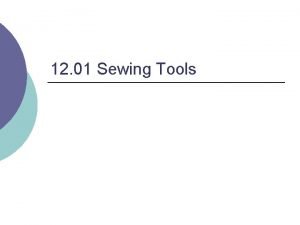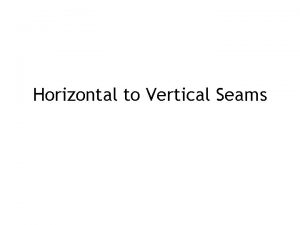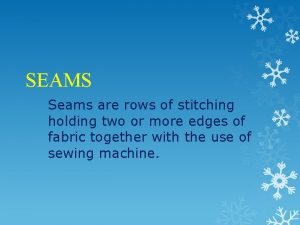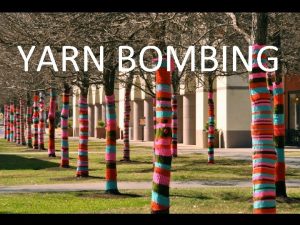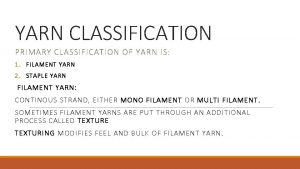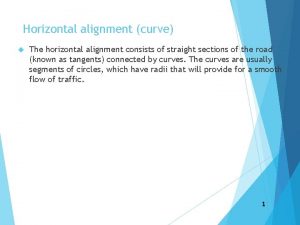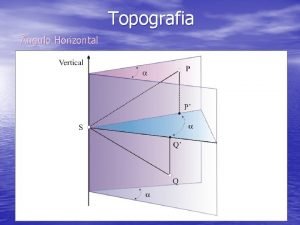Horizontal Seams Yarn for Seaming Use yarn used
















































- Slides: 48

Horizontal Seams

Yarn for Seaming • Use yarn used for item except: – Novelty yarn – Mohair – Nubby or bumpy yarn • When substituting – Match color and washability – Use knitting yarn, needlepoint wool or embroidery thread

Seaming Order for a Garment • • Join shoulders Attach sleeves Seam sleeves from wrist to underarm Seam sides from bottom to armhole

Fundamentals • Block your swatches • Take your time • Plan ahead – Don’t inc or dec in the selvedge – Think about your stitch or color pattern – Allow a selvedge stitch for seaming • Seam on a table with the right side up • Match up CO and BO edges

Planning for All Horizontal Seams Make sure there are the same number of stitches on each of the pieces you’ll be joining.

Knit Stockinette Stitch V

BO EDGE TO BO EDGE

Place BO edges together with RS sides up.

Identify where stitches are below the BO edge. VVVVVVV Bound Off Edges Stitches VVVVVVV

Place markers in stitches below the BO edge every five or six stitches. That’s where tapestry needle goes in and out.

On bottom piece insert needle into first stitch, run under the stitch gap and bring out through center of second stitch.

On the top piece, insert needle into first stitch, run under the stitch gap and bring out through center of second stitch.

On bottom piece insert needle back into second stitch, and bring through the center of third stitch.

On the top piece insert needle back into the center of the second stitch, and bring through the center of third stitch.

Repeat until all stitches are joined, removing markers and pulling yarn as you go. Note: Do not pull stitches too tight; the tension should look like a row of knitting.

BO to BO Edge All Up 1. Place BO edges together with RS up. 2. Find the stitches below the BO edge on each piece and identify where the tapestry needle goes. 3. On bottom piece, insert needle into first stitch, run under the stitch gap and bring through center of second stitch. 4. On top piece, insert needle into first stitch, run under the stitch gap and bring through center of second stitch. 5. On the bottom piece, insert needle back into center of second stitch, and bring through center of third stitch. 6. On the top piece, insert needle back into second stitch, and bring through center of third stitch. 7. Repeat until all stitches are joined.

STAIR STEP SEAM

Place BO edges together with RS sides up.

Identify the top of each column of stitches and place marker on top of columns on either side of stair steps. This is where tapestry needle goes.

Be sure to avoid the holes at the stair steps!

On bottom piece, insert needle into first stitch, run under the stitch gap and bring through center of second stitch.

On top piece, insert needle into first stitch, run under the stitch gap and bring through center of second stitch.

On the bottom piece, insert needle back into second stitch, and bring through center of third stitch

On the top piece, insert needle back into second stitch, and bring through center of third stitch.

At the jog be sure to go in where the marker is!

And come out where the next marker is! If you insert where the hole at the stair step is, it makes a bigger hole.

Do the same on the top!

Repeat until all stitches are joined Note: It’s a good idea to remove markers after each gap.

Pull yarn tight. Note: Do not pull stitches too tight; the tension should look like a row of knitting.

Stair Step Seam All Up 1. Place BO edges together with RS up. 2. Find the stitches below the BO edge on each piece and identify the columns of stitches. 3. Place markers at top of columns on either side of gaps. 4. On bottom piece, insert needle into first stitch, run under the gap and bring through center of second stitch. 5. On top piece, insert needle into first stitch, run under the stitch and bring through center of second stitch. 6. On the bottom piece, insert needle back into center of second stitch, and bring through center of third stitch. 7. On the top piece, insert needle back into second stitch, and bring through center of third stitch. 8. Repeat until all stitches are joined being careful to skip the holes at each stair step.

THREE NEEDLE BIND OFF

Hold two pieces with right sides together. Needles will be parallel.

Insert third needle knitwise into first stitch on each needle.

Wrap yarn.

Pull through to knit stitches together.

Knit second two stitches together.

Then pass first stitch over second stitch as in a normal bind off.

Repeat until all stiches are bound off.

Pull yarn tight. Note: Do not pull stitches too tight.

Three Needle Bind Off 1. Place two pieces with right sides together. Needles will be parallel. 2. Insert third needle knitwise into first stitch on each needle. 3. Wrap yarn and pull through to knit stitches together. 4. Knit together the second stitch from each piece. 5. Pass first stitch over second stitch as in a normal bind off. 6. Repeat until all stitches are bound off. 7. Tighten yarn.

THE MYSTERY OF THE GD KITCHENER STITCH* *Recently down-graded from the f-ing Kitchener Stitch

The Kitchener Mystery Part 1 I know the pattern is Work stitch and drop, do the opposite on the next stitch and leave in on the needle: but I never know which needle to do knit on and which needle to purl on.

Part 1 Solved Hold the needles parallel with the wrong sides facing each other. Now look at your needles. If the stitches you’re about to work have the knit side facing you: Knit, drop, purl If the stitches you’re about to work have the purl side facing you: Purl, drop, knit Or to put it another way: What you see is what you do first.

The Kitchener Mystery Part 2 But you work the first two stitches differently and I can never remember what it is I need to do.

Part 2 Solved You’re just working the second half of the pattern on both needles. So… – Purl the first stitch on front needle leaving on needle. (The last part of Knit, drop, purl. ) – Knit the first stitch on back needle leaving on needle. (The last part of Purl, drop, knit. ) Think about that for a minute and picture it. It will make sense if you do.

Kitchener Stitch Seam • Place the two pieces with wrong sides together so that the needles are parallel. • With the tapestry needle purl the first stitch on the front needle leaving it on the needle. • With the tapestry needle knit the first stitch on the back needle leaving it on the needle. • For all remaining stitches use the tapestry needle to: – Knit the first stitch on the front needle, drop off; purl next stitch and leave on the needle. – Purl the first stitch on the back needle, drop off; knit next stitch and leave on needle. • Tighten as you go along.

One more Kitchener Tip The yarn used to seam with the Kitchener Stitch should be 3 times as long as the seam plus 10” for yarn ends to be woven in.

It does make a nice stitch.
 Folded seam sheet metal
Folded seam sheet metal Lock seam joint
Lock seam joint Waxy coated paper which transfers pattern markings
Waxy coated paper which transfers pattern markings Countersunk lap seam
Countersunk lap seam Vertical seams
Vertical seams Fspos
Fspos Typiska drag för en novell
Typiska drag för en novell Tack för att ni lyssnade bild
Tack för att ni lyssnade bild Vad står k.r.å.k.a.n för
Vad står k.r.å.k.a.n för Varför kallas perioden 1918-1939 för mellankrigstiden?
Varför kallas perioden 1918-1939 för mellankrigstiden? En lathund för arbete med kontinuitetshantering
En lathund för arbete med kontinuitetshantering Personalliggare bygg undantag
Personalliggare bygg undantag Tidbok
Tidbok Sura för anatom
Sura för anatom Vad är densitet
Vad är densitet Datorkunskap för nybörjare
Datorkunskap för nybörjare Stig kerman
Stig kerman Hur skriver man en tes
Hur skriver man en tes Autokratiskt ledarskap
Autokratiskt ledarskap Nyckelkompetenser för livslångt lärande
Nyckelkompetenser för livslångt lärande Påbyggnader för flakfordon
Påbyggnader för flakfordon Lufttryck formel
Lufttryck formel Publik sektor
Publik sektor Jag har nigit för nymånens skära
Jag har nigit för nymånens skära Presentera för publik crossboss
Presentera för publik crossboss Jiddisch
Jiddisch Bat mitza
Bat mitza Klassificeringsstruktur för kommunala verksamheter
Klassificeringsstruktur för kommunala verksamheter Epiteltyper
Epiteltyper Claes martinsson
Claes martinsson Cks
Cks Lågenergihus nyproduktion
Lågenergihus nyproduktion Bra mat för unga idrottare
Bra mat för unga idrottare Verktyg för automatisering av utbetalningar
Verktyg för automatisering av utbetalningar Rutin för avvikelsehantering
Rutin för avvikelsehantering Smärtskolan kunskap för livet
Smärtskolan kunskap för livet Ministerstyre för och nackdelar
Ministerstyre för och nackdelar Tack för att ni har lyssnat
Tack för att ni har lyssnat Referat mall
Referat mall Redogör för vad psykologi är
Redogör för vad psykologi är Borstål, egenskaper
Borstål, egenskaper Atmosfr
Atmosfr Borra hål för knoppar
Borra hål för knoppar Vilken grundregel finns det för tronföljden i sverige?
Vilken grundregel finns det för tronföljden i sverige? Relativ standardavvikelse formel
Relativ standardavvikelse formel Tack för att ni har lyssnat
Tack för att ni har lyssnat Steg för steg rita
Steg för steg rita Verksamhetsanalys exempel
Verksamhetsanalys exempel Tobinskatten för och nackdelar
Tobinskatten för och nackdelar


